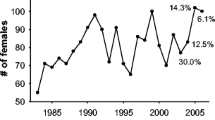Abstract
We quantified: (1) growth rate, (2) length-mass relationships, (3) size- and age-specific fecundity, (4) egg size-frequencies, and (5) size- and age-specific egg diameter relationships for reproductively active female C. bairdi from one of the southern-most extant populations of this species (Coweeta Creek drainage, North Carolina). Gravid females were collected during February and March in 1993–1995, and 1998. Cottus bairdi reached an age of 7+ and 79 mm standard length. The youngest and smallest gravid female collected was a 41 mm 1+ individual. Mature 1+ females were not uncommon and we collected 21 during our study. All females older than age 2 were mature. Mean fecundity for C. bairdi at Coweeta was 71 eggs (range 9–166 eggs). We found significant positive relationships between fecundity and female length, weight and age. Female length and weight also significantly affected mean egg diameter, although the relationship was not linear. Neither female size or age significantly affected mean maximum egg diameters. Female C. bairdi from the Coweeta Creek drainage possess a unique suite of reproductive characteristics that may represent adaptations to the local selective regime or ecophenotypic variation.
Similar content being viewed by others

References cited
Bagenal, T.B. & E. Braum. 1978. Eggs and early life history. pp. 165–201. In:T.B. Bagenal (ed.) Methods for Assessment of Fish Production in FreshWaters, Blackwell Scientific, Oxford.
Bailey, J.E. 1952. Life history and ecology of the sculpin Cottus bairdi punctulatus in southwestern Montana. Copeia1952: 243–255.
Breder, C.M & D.E. Rosen. 1966. Modes of reproduction in fishes. Natural HistoryPress, Garden City. 941 pp.
Dehaven, J.E., D.J. Stouder, R. Ratajczak, T.J. Welch & G.D. Grossman. 1993.Reproductive timing of three fish in a southern Appalachian stream. Ecol. Freshwat. Fish 1: 104–111.
Downhower, J.F. & L. Brown. 1980. Mate preferences of female mottled sculpins, Cottus bairdi. Anim. Beh.28: 728–734.
Freeman, M.C., M.K. Crawford, J.C. Barrett, D.E. Facey, M.G. Flood, J. Hill, D.J. Stouder & G.D. Grossman. 1988. Fish assemblage stability in a southern Appalachian stream. Can. J. Fish. Aquat. Sci. 45: 1949–1958.
Girard, C. 1850. Contributions to the natural history of the freshwater fishes of America. I. Amonograph of the cottids. Smithsonian Institution Contribution to Knowledge 3: 1–80.
Grossman, G.D. 1979.Demographic characteristics of an intertidal bay goby (Lepidogobius lepidus). Env. Biol. Fish. 4: 207–218.
Grossman, G.D., J.F. Dowd & M.C. Crawford. 1990. Assemblage stability in stream fishes: a review. Environ.Manage. 14: 661–671.
Grossman, G.D. & M.C. Freeman. 1987. Microhabitat use in a stream fishassemblage. J. Zool. Soc. (London) 212: 151–176.
Grossman, G.D., J. Hill, & J.T. Petty. 1995a.Observations on habitat structure, population regulation, and habitat use with respect to evolutionarily significant units: a landscape approach for lotic systems. Amer. Fish. Soc. Symp. 17: 381–391.
Grossman, G.D., R. Ratajczak, Jr. & M.C. Crawford 1995b. Do rock bass (Ambloplites rupestris) induce microhabitat shifts in mottled sculpin (Cottus bairdi). Copeia 1995: 343–353.
Grossman, G.D. & R.E. Ratajczak, Jr. 1998. Long-term patterns of microhabitatuse by fish in a southern Appalachian stream from 1983 to 1992: effects of hydrologic period, season, and fish length. Ecol. Freshwat. Fish 7: 108–131.
Grossman, G.D., R.E. Ratajczak, Jr., M. Crawford & M.C. Freeman. 1998.Assemblage organization in stream fishes: effects of environmental variation and interspecific interactions. Ecol. Monogr. 68: 395–420.
Hahn, H.W. 1927. The history of the germ cell of Cottus bairdi Girard. J. Morph. Physiol.43: 427–497.
Jenkins, R.E. & N.M. Burkhead. 1994. Freshwater fishes of Virginia. AmericanFisheries Society, Bethesda. 1080 pp.
Ludwig, G.M. & E.L. Lange. 1975. The relationship of length, age, and age-length interaction to the fecundity of the northern mottled sculpin, Cottus b. bairdi. Trans. Amer. Fish. Soc. 105: 64–67.
Ludwig, G.M. & C.R. Norden. 1969. Age, growth, and reproduction of the northern mottled sculpin (Cottus bairdibairdi). Milwaukee Public Museum Occasional Paper 2: 1–67.
Nagel, J.W. 1980. Life history of the mottledsculpin, Cottus bairdi, in northern Tennessee (Osteichthyes: Cottidae). Brimleyana 4: 115–121.
Patten, B.G.1970. Spawning and fecundity of seven species of northwest American cottus. Amer. Midl. Nat. 85: 493–506.
Petty, J.T. 1998. Mottled sculpin in a dynamic landscape: linking environmental heterogeneity, individual behaviors, andpopulation dynamics in a southern Appalachian stream. Ph.D. Dissertation, University of Georgia, Athens. 156 pp.
Petty, J.T & G.D. Grossman. 1996. Patch selection by mottled sculpin (Pisces: Cottidae) in a southern Appalachianstream. Freshwat. Biol. 35: 261–276.
Ricker, W.E. 1975. Computation and interpretation of biologicalstatistics of fish populations. Department of the Environment, Fisheries, and Marine Service, Ottawa. 382 pp.
Rohde, F.C. & R.G. Arndt. 1981. Life history of a coastal plain population of the mottled sculpin, Cottus bairdi (Osteichthyes: Cottidae), in Delaware. Brimleyana 7: 69–94.
SAS Institute. 1985. SAS user's guide; statistics. Cary 956 pp.
Simon, J.R. & R.C. Brown. 1943. Observations on the spawning of the sculpin. Copeia. 1943: 41–42.
Smith, B.G. 1922. Notes on the nesting habits of Cottus. Pap. Mich. Acad. Sci. Arts & Letters 2: 212–224.
Sokal, R.R. & F.J. Rohlf. 1995. Biometry: the principles and practice of statistics in biological research, 3rd edn. Prentice-Hall, Upper Saddle River. 880 pp.
Swank, W.T. & D.A. Crossley. 1987. Forest hydrology and ecologyat Coweeta. Springer-Verlag, New York. 469 pp.
Thompson, A., J.T Petty & G.D. Grossman. 2001. Multi-scale effects of resource patchiness on foraging behaviour and habitat use by longnose dace, Rhinichthys cataractae. Freshwat. Biol. 46: 145–161.
Von Bertalanffy, L. 1938. A quantitative theory of organic growth (inquiries on growthlaws. II). Hum. Biol. 10: 181–212.
Wootton, R.J. 1998. Ecology of teleost fishes. Chapman & Hall, London. 392 pp.
Zar, J.M. 1996. Biostatistical analysis, 3rd edn. Prentice-Hall, Upper Saddle River.931 pp.
Zarbock, W.M. 1952. Life history of the Utah sculpin, Cottus bairdi semiscaber (Cope), in Logan River, Utah.Trans. Amer. Fish. Soc. 81: 249–259.
Author information
Authors and Affiliations
Rights and permissions
About this article
Cite this article
Grossman, G.D., McDaniel, K. & Ratajczak, R.E. Demographic Characteristics of Female Mottled Sculpin, Cottus Bairdi, in the Coweeta Creek Drainage, North Carolina. Environmental Biology of Fishes 63, 299–308 (2002). https://doi.org/10.1023/A:1014315623637
Issue Date:
DOI: https://doi.org/10.1023/A:1014315623637



